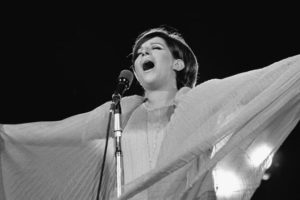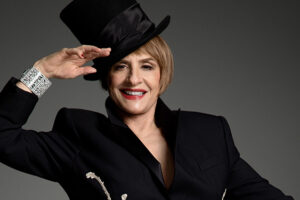

In a lifetime of opera-going and amassing a recording collection in which I have unwittingly become the chief librarian of what could only be dubbed “The Patrick Mack Operatic Archive” I have never actually seen Rigoletto performed live.
All that changed when LA Opera opened their revival at the Music Center Saturday night. It’s not that I don’t like the work, mind you, but who can get excited over Rigoletto? Its plot is conventional to a fault (or is it?) and it’s chock full of some very good tunes that give three singers, of more than adequate skill, moments to shine.
Still it fairly reeks of operatic cliché. But the force of this piece, both musical and dramatic when given a spirited live performance, proves nearly irresistible to any admirer of opera.
Not that last night’s performance of Giuseppe Verdi’s toe-tapper was perfect, nay far from it, but like Puccini’s La Boheme its near bulletproof construction and inspiration of melody go a long way towards smoothing out the rough spots (which I will now list with avidity).
My excitement at attending this performance initially hinged on the announcement that Leo Nucci, who seems determined to give a certain Spaniard a run for his money, was announced as Verdi’s beleaguered court jester.
Having never seen him live either it seemed only fitting. Yet is was not to be and LA Opera announced in March that Maestro Nucci was curtailing his performances outside of Europe and that Juan Jesus Rodriguez would don the motley in his stead.
Mr. Rodriguez has enjoyed a considerable career in his native Spain and in Europe and only made his Met debut in 2016 in Trovatore.It was apparent from the outset that this was not his first trip to Mantua.
His command of the role was considerable and you need a seasoned pro in this part because Rigoletto has a lot of balls in the air (so to speak). Dramatically he knew exactly where he was and what he was doing. He’s also one of those artists who knows how to spotlight himself at the right moments to gain the audience’s attention before he does something of import.
The voice itself is just short of magnificent. An ease of production throughout the range and especially strong in the upper quadrant where Verdi likes to bring the baritone thunder. There was a moment at the beginning of the duet with Gilda where I was starting to find him lacking in nuance and he then proceeded to join two lines together in one breath.
His “Cortigiani” easily brought the house down. Still his is not so much the tortured, introspective, jester of the second half of that great aria as the angry, vengeful, father of the fiery beginning. But I quibble and this is an important portrayal that more than fulfills the enormous demands the composer makes of any singer who attempts it.
Having enjoyed Lisette Oropesa in the recent OrphéeI was eager to make my acquaintance with her Gilda and she alone, amongst a talented cast, was the one who consistently spun vocal gold. Her formidable technical prowess constantly brought pleasure and astonishment to the ear. Her breath control and fluency above the staff were magical and her touching, nervous, sincerity in the opening scene laid the foundation for the sacrifice to come in the last.
Her “Caro nome” was a veritable how-to manual on holding an audience enraptured. Her final moments, with her beautiful arching messa di voce lines, were the very definition of what the the Italians call “la bella morte.”
If I found her lacking in anything it was in the bright staccato play that you get with a coloratura in the role rather than the full lyric voice that Ms. Oropesa wields. All the better to fill out those ensembles with needless to say.
Our not so noble Duke was Arturo Chacón-Cruz whom we last saw here as Verdi’s Macduff. Generally he bawled his way through the role but, he wouldn’t be the first and, not without a modicum of charm. It’s a bantamweight lyric tenor with a secure top that he took pleasure in showing off.
He was good in the quick passage work of the opening scene and his Italian had the most flavor of any of colleagues on stage. For the climactic high note of “La donna e mobile” he played completely to the crowd (in the wrong way) with both hands raised in brazen victory over the opposing team. (I have a friend who calls that “opera for the deaf.”)
On the plus side he and Ms. Oropesa exhibited such passionate chemistry together that the cadenza that closed “È il sol dell’anima”was nothing less than a sexual act. That was another first for me.
A fairly stellar supporting cast included LA Opera favorite Morris Robinson as a malevolent Sparafucile dipping down below the ledger lines to sinister effect. A very plummy Ginger Costa-Jackson as his sister Maddalena whom I wouldn’t turn my back on in a dark alley.
As the Countess Ceprano Liv Redpath was delicious and made the most of her brief interview with the Duke in the opening scene.
This production was new to San Francisco Opera in 1997 and borrowed here before for the 2010 season. Michael Yeargan’s unit set features leftover colonnades from his “Light in the Piazza” and was lit in the bright style and bold colors of Italian cinematographer Vittorio Storaro by Robert Wierzel.
The last scene featured a little theatrical magic in the form of a canal running to the front of the stage. My only disappointment was the storm which didn’t build to a climax but just happened and the Bauhaus interior of Rigoletto’s home which was barren of any suggestion of detail.
Constance Hoffman’s opulent costumes brought a welcome Renaissance feel to the proceedings and the chorus was well turned out for debaucheries of the opening scene. Even Gilda’s simple smock for act one and was perfectly executed as was the soiled hem of her chemise during her reconciliation scene with Rigoletto.
Director Mark Lamos is an old hand at opera by this point but there were a few things I found odd in his staging. His blocking of the “Addio” at the end of the duet between Gilda and the Duke elicited titters from the audience which is the wrong response.
One would think it would reflect the passion of two lovers who can’t bring themselves to separate. Especially since they’d practically burned the stage down with that cadenza a moment before. At the end of the Duke’s “Possente amor” he had Mr.Chacón-Cruz carried offstage (to violate the soprano) on the shoulders of his courtiers.
Gilda’s “Tutte le feste” was barely over when suddenly she was climbing onto her father’s lap which was awkward at best and at worst sent the wrong message. Outside of these few head scratchers the staging was able and the kidnapping of Gilda was handled very well for a change.
Our Maestro for the evening was wunderkind Matthew Aucoin who in 2016 was LA Opera’s first ever Artist-in-Residence. The opening line of his online bio reminds us he’s not yet 30 and he’s also a promising composer.
I don’t think I’ve ever seen a conductor lead an entire opera with so little regard to time signature or meter. More than once he started a tempo only to set another faster one a few bars in. That said, once he corrected himself he usually got it right.
The LA Opera Orchestra responded with blocks of sound without their usual sheen and with little of the clarity we’re used to hearing from them. The fact that the performance went as well as it did seemed almost more in spite of him than because of.
It’s a good production with a fine cast that’s hard to beat except that is exactly what LA Opera plans on trying when Ambrogio Maestri, Adela Zaharia and Michael Fabiano take over for the last three performances starting on the May 27.
Photo: Ken Howard / LA Opera























Comments